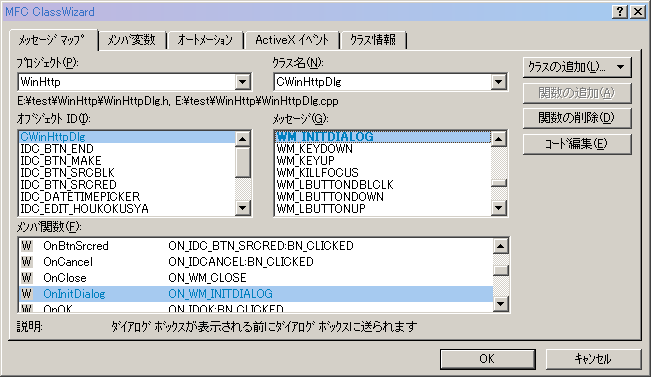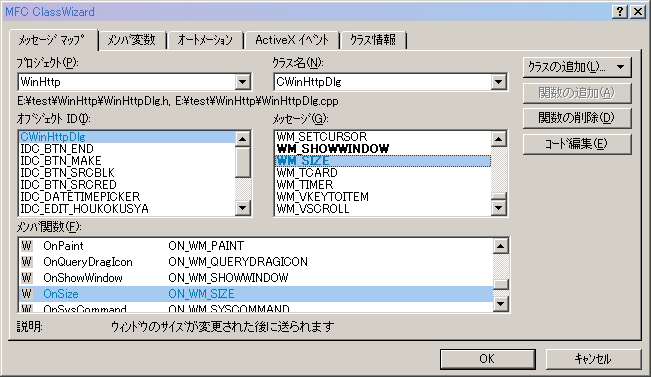ダイアログにステータスバーをつける手順を示します。
まず、ステータスバーをつけたいダイアログのメンバに、
CStatusBarのインスタンスを追加します。
class CMyDlg : public CDialog
{
// 構築
public:
CMyDlg(CWnd* pParent = NULL); // 標準のコンストラクタ
// :
// 省略
// :
CStatusBar m_StatusBar;
};
次に、OnInitDialog()メソッドを(もしまだしていなければ)オーバーライドします。

オーバーライドしたOnInitDialog()メソッド内で、
ステータスバーの作成を行います。
BOOL CMyDlg::OnInitDialog()
{
CDialog::OnInitDialog();
// ステータスバーを作成・付加
m_StatusBar.Create(this);
// ステータスバーの大きさを取得
CRect rectSt;
m_StatusBar.GetWindowRect(rectSt);
// ダイアログのクライアント領域のサイズを取得
CRect rectClient;
GetClientRect(&rectClient);
// ステータスバーの高さを保持して大きさを
// ダイアログのクライアントウィンドウの
// 大きさにあわせる
const int nHeight = 19;
rectSt.top = rectClient.bottom - nHeight;
rectSt.bottom = rectSt.top + nHeight;
rectSt.left = rectClient.left;
rectSt.right = rectClient.right;
m_StatusBar.MoveWindow(rectSt);
return TRUE; // コントロールにフォーカスを設定しないとき、戻り値は TRUE となります
// 例外: OCX プロパティ ページの戻り値は FALSE となります
}
これでステータスバーを付加することができました。
もしサイズ変更可能なダイアログの場合、
サイズ変更時にステータスバーも動かしてやる必要があります。
サイズ変更時にステータスバーを移動するには、
OnSize()メソッドを(もしまだしていなければ)オーバーライドします。

OnSize()メソッドに、次の内容を追加します。
void CMyDlg::OnSize(UINT nType, int cx, int cy)
{
CDialog::OnSize(nType, cx, cy);
CRect rectClient;
// ステータスバー
int nStatusHeight = 0;
if(m_StatusBar.GetSafeHwnd()){// コントロールの有効性をチェックします。
CRect rectSt;
m_StatusBar.GetWindowRect(rectSt);
// 現在のクライアントウィンドウのサイズを取得
GetClientRect(&rectClient);
// 高さを維持しながらサイズを変更する
int nBtm = rectSt.bottom - rectSt.top;
rectSt.top = rectClient.bottom - nBtm;
rectSt.bottom = rectSt.top + nBtm;
rectSt.left = rectClient.left;
rectSt.right = rectClient.right;
m_StatusBar.MoveWindow(rectSt);
nStatusHeight = rectSt.Height();
}
}
これで、サイズ変更にも対応できます。
| 
